Still life add pictures. Still life is an image of inanimate objects. Paintings by genres. Still life in different styles and within the art
Still life(Fr. Nature morte - "nature is dead") - the image of inanimate objects in imaginative mystery, On the view of portrait, genre, historical and landscape themes.
I can see the point of early still life in the XV-XVI centuries, if I saw it as a part of the historical or genre composition. For the last hour, the still life has taken over the links with the religious picture, framed by the quilt garlands of the figurines of the Mother of God of Christ, and also often depicted on the ringing boat of the antique image (as in the "Triptych of the family of van Shlubey" by Roger) Also in the 16th century the tradition of depicting portraits from images of the skull was expanded, for example, the portrait of Jean Carondel of the robot Jan Gossart (div. Vanitas). Early still lifes often used the utilitarian function, for example, to embellish the shafi chairs or to mask the stools.
Still life in different styles and within the art
A still life is born yak sukupn_st of inanimate objects, roztashovanyh at once in a singing rank. The magic of pictures of still lifes of the field lies in the fact that the stench can show us a new way to look at the various objects around us. As soon as the stench will be displaced into a singing layout, and then you will be thrown into fancy, chornil, pastel, or if you are the middle one, you will create a completely new meaning. The stench is permeated by the poses of the zvychayom. Їх іsnuvannya to be restructured in hours.
Still life is left to form as an independent genre of painting among the creativity of Dutch and Flemish artists of the 17th century. Subjects in still-life painting of the current period often revenge on alegoria - either the shyness of all earthly and inevitability of death (vanitas), or - in a wider sense of the Passion of Christ and the Resurrection. The price of the meaning is passed on for help with the vicariousness of objects - in a large variety of known and developed in everyday life, as they need additional symbolic meanings.
Still life in Russian painting
Without hesitation, we were baching pop-art celebrities at the same time of our life. Seeing an extravagant strav soup is just a stupid object, they didn't think about what kind of two they didn't think, if they let you into your cat. Ale the beast of Warhol to the subject was robbed of a colossal, great soup, no life, an image, which is needed to rakhuvatisya! Ob'єkti, vibrani for still life, often have a special meaning, either on a special, cultural, huge, religious or philosophical level. Those who feel good about creating art often provoke introspection and mindfulness.
Dutch still life XVII stolittya
The Dutch still life, representing a unique cultural phenomenon of the 17th century, has celebrated the inflow of a further development of all European painting. "Little Dutchmen" saw in their robots light objects, as they live their quiet, overtaken lives. The term “caught life” (head Stilleven, new. Stilleben, English Still-life) became accustomed to the genre in the middle of the 17th century, from the Netherlands. Until then, the artists named some of the paintings, describing the plot: "Little Snidanok", "Bouquet of Quites", "Mislivsky Trophy", "Sueta Sut". The main shift of the designated term is to be found in literature - "quiet, unruly life."
The mode of viewing the objects can display a wide range of images, in the form of deposits, as well as illumination, selection of colors and processing of farbi. The stench is especially important for looking, if you open it. Do not be impatient, we can see the skin from these points of the distance. The subject of still life paintings is represented by objects, such as images in paintings. See for yourself the actions of the objects of natural still life, as they appear in in home still lifes stretching out all the history! Follow the symbolism and the meaning of the objects with the butts of the still life.
Still life in Russian painting 18-20 stolit
Still life yak independent genre of painting appeared in Russia in on the cob xviii stolittya. The announcement of a new collection of bulo is tied to the images of the gifts of the land and the sea, good news speeches to cheer up the people. Right up to the end of the 19th century, still life, in the view of a portrait and historical picture, looked like a "lower" genre. Winning as the head of the rank, it was the initial production and it was allowed only in the interlaced pinkie as the painting of kvitiv and fruit.
If you are astonished at painting a still life, or if you open the door, you can feed yourself: "What does it mean?" Tse vipadkova collection of objects, or the artist mav specifically namir when choosing? It is easy to wonder at the picture and think: "Hmm, beautiful objects", and quickly go to the next picture, ale artistic robots zazvychay go to nabagato glibshe, nіzh just push in beautiful objects. It is necessary to build a piece of shmat without a blindfold, depending on the main process of the targeting, which is to stand behind the robot.
Themes for still life painting can be special, cultural, social, mythological, religious or philosophical and existential. For the stench can be based on material qualities, such as color or texture. The stench can be found chimerically grounded on objects, which can be repaired from the same alphabet, or speeches, as you can know in a typical unaddressed box in the kitchen. I, slyly, all of them can be crooked, so we can weave a big ball tapestry with those and sense within the framework of one creation of art!
The ear of the XX century was marked by the development of Russian still life painting, for the first time the equal parity of the middle genres became known. Pragnennya artists in expanding the possibilities of imaginative moving and supervising with active jokes in the field of color, form, composition. Everything is especially brightly manifested in still life. The idea of new themes, images and artistic primes, the Russian still life evolving superstitiously, is fast: for the past ten years, walk through the path from impressionism to abstract formwork.
Historically, still-life paintings by boules are very well crushed by a religious and mythological zmist. Tse bulo vіdobrazhennyam hour; Bula church center haunted life... The hierarchy of the classes of the Bula is gliboko woke up - everyone knew their place and lost in the new. Up to the 16th century, the suspension is changing. In the world of that, as science has grown into a greater stronghold, the relevance of those fell on the Uzbek. Now, the natural light will be cascaded and recorded by itself, and not religious or mythological. Oscillations of the history of gurkotyl until the middle of the 19th century, the image of natural light was repaired by the modi.
In the 30s-40s of the 20th century, the number of developments has begun to grow, even since the mid-50s, still life is experiencing in Radiansk painting a new one for the rest of the hour and is firmly in time with the other genres.
Russian still life
- Khrutsky Ivan Khomich (1810-1885)
- Grabar Igor Emmanuylovich (1871-1960)
- Petrov-Vodkin Kuzma Sergiyovich (1878-1939)
- Konchalovsky Petro Petrovich (1876-1956)
- Alberti Petro Pilipovich (1913-1994)
- Antipova Evgeniya Petrivna (1917-2009)
- Zakharov Sergiy Yukhimovich (1900-1993)
- Kopitseva Maya Kuzmivna (1924-2005)
- Kotyants Gevork Vartanovich (1906-1996)
- Krestovsky Yaroslav Ihorovich (1925-2003)
- Osipov Sergiy Ivanovich (1915-1985)
- Late Mykola Matviyovich (1930-1978)
- Rumyantseva Kapitolina Oleksiyivna (1925-2002)
- Skuin Olena Petrivna (1909-1986)
- Teterin Viktor Kuzmich (1922-1991)
- Shamanov Boris Ivanovich (1931-2008)
Still life as an independent genre of painting took shape in the 17th century. in the creativity of Dutch and Flemish artists.
Analysis of a still life behind a zmist
Now the light of the mistress is greater than that of our internal light attitudes and emotions. Until the end of a thousand years of objects, images in paintings, visions as a product and knowledge for their commercialization, as pop-art and photo realism in the ruins. If you didn’t pick it up, because you went through the history of still life as an artist's form, allow me to scribble it, embedding it, as one of my paintings “Zhovto-Pomarancheva” is looking for a sprinkle of new themes.
Well, let's be amazed closer. In the picture there are chotiri objects: a rolling jerk, a trickle in the eye of plastic obgorttsi, topi-pop and shining marmur. Well, most obvious rice spіlna, It is also represented in the name of a shmat, є perevazhayuschie colors of the same і orange colorіv. The price of the object, all of which I think I will match the color scheme, the smell is good at once visually.
Until the end of the day, it has not become an independent genre, but has not been included in the genre of framing other paintings (for example, with quilt garlands), embellishing furniture, interior decoration, etc.
term
The word "still life" in French means "nature is dead" (nature morte). Kvіti u vazі - tse still life; there are also apartments on the flower beds or in the palisadnik - a landscape. A wide sense of a still life - tse art inanimate objects: roslin, game, dishes, etc. The artist does not depict objects "from nature", like the stench of being roasted in the interior, but rather compose them this way, I like my sense of the artist and the artist's task.
Often still life is to avenge the prikhovani of alegoria through the vicarious objects of ancient objects, as the artist nominated a symbol, an additional zmist and meanings. The butt of alegorical still life is vanitas (from Latin vanitas "suєta, Marnoslavstvo").
What's all that they have spіlnogo? Let's take a look at the function - why does the stench of vikoristvoyutsya in the haunted life? Hmm, tsi ob'єkti mean fun for the child! In the picture, the stench is the sukupnist of objects, unruly on the suvor white aphid. The stench symbolizes the potential for fun, and also wicks at the memory of the fun. The whole stink is just there.
Well, feed yourself: what on the white dust my eyes and rosum robiti? In principle, biliy von zmushu you zoserediti your direct respect on ob'ykty. The stinks are bigger, but not even callous, they are floating in space - they still have thin tins, as they start their own place in space. At my glance, the background will help you to things that are more significant. Tobto stink is a stereotypical emblem of childishness. The stink of a pose for an hour and not tied to singing song... The stench could drift into your whites.
see still life
vanitas
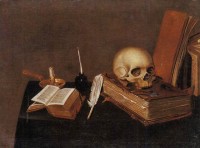
Michael Konrad Hirt. vanitas
Vanitas is an allegorical still life. Call on new, middle, the skull is displayed. Such a still life of meanings for nagaduvannya about the versatility of life, the marrow satisfaction and the inevitability of death - thinking over the sense of a human being. The term of taking from virsha from Biblii: "Suta sut, saying Propovidnik, marnota marnot, - all suta!". For Latin tse sounded like this: " Vanitas vanitatum dixit Ecclesiastes vanitas vanitatum omnia vanitas". More reports about vanitas can be read.
There is one of the ways of interpreting a picture. Remember, there is only one interpretation. The whole form is spilkuvannya, and the history will not end if the brush overlaps the canvas. If you are wondering at the tvir of mystery, the stench to bring with you all your life dosvid, all your unique help, all your knowledge and intelligence all the dosage. Oh, the mind is in conjunction with the images, if these eyes move over the shmat. Be the head of the talented house of mind and interpretation, and such is the beauty of spilkuvannya.
Shvidshe for everything, "still life" is not a phrase, how to get started and set up your pulse races. Shvidshe for everything, tse vykliche formally thought out fruits, gilochok roslin or vaz z kvitiv. You can, tse bring the cinnamon to the dark, musty, traditional compositions, as your eyes pass in the gallery, quickly passing to great and lively speeches.
Dutch still life
Dutch still life, which took shape in the 17th century. as an independent genre, having infiltrated the development of all European painting. Appear, special objects can also live, but life is quiet and uncomfortable for people. Wu tsomu є yakas tamnitsa. Mabut, the genre of still life has become popular and has survived to our days. Innocent still life attracts a glance, hvilyuє feminine, as if it is unfortunate to see - win as a society, shvidkoplinni help ...
Historically, the still life has occupied the lower gap of the "ієrarchії genres" in the imaginative mystery. At the eighteenth century, the French King's Academy Virishila, "Lyudin Bula miril all speeches", and the landscape and still life bully "Nizyzhchy" form of painting, so that the subject of the people does not joke. Still life, in these words, is simple: whether it’s a little peach, ale vin imovirno taking the mastery of the craft, in order to depict a walnut legend or a biblian history.
Happily, everything has changed since the eighteenth century, and now we can look back and wonder why the still life of the ravings of the historical rap has not been lost. How can life tell us about something? Perche, still life can become a portal for an individual image of history. The singing sense of the tse is even more intimate: objects, images by the artist, show those who stink in any way to social, or cultural, or special meanings for them.
quilt still life
This is a kind of still life, mabut, the most popular and the best, which has been seen in the near-term genre.

Jan Davids de Hem (1606-1684). Still life with a square vase (close to +1645). National Gallery of Art (Washington)
Traditionally, in the Netherlands, they grew a lot of kvitiv, planted gardens, so kvitkovi still life boiled to the natural advancement of the life of the suspension. The most famous artists of the boule genre are Ambrosius Bosschaert the Elder (1573-1621) and Balthasar van der Ast (1593-1657).
To marvel at the socially realist ruh, as a vicarious mystery, to screw up the respect to the minds of the life of the wicked people. The whole still life told us about the realities of the traditional British still life: replacing the root of the traditional still life, which is based on natural products, Brothers painted objects that were known about a representative of the typical home-style kitchen style.
If the still life has collapsed? Still life has been for a long time, like showing pictures, known on the walls of the furnaces and from the volcanic Pompeii. More and more middle class pragnuv prybati and show mystery, ale historical and religious paintings turned out to be unpopular. Still life is simple and accessible to artists: the stench is not guilty, but it’s not a matter of paying someone to sit behind them, just try to organize the objects around them.

Ambrosius Bosshart the Elder “Tulips, Trojandi, Bili and Roses, Carnations, Forget-me-nots and іnshі Kіti у Vazі" (c. 1619). Oil on mіdі
vcheny still life
Naybilsh is an intellectual view of a still life. In such still lifes, a thought over the image was transferred, and for the whole - the knowledge of the Bible and the knowledge of light. In this category, you can bring і vanіtas, аll vіdnіvnі still life s themes wider: in the new presence of books, musical instruments, etc.
This is how the Dutch tradition of still life painting vibrated, for the participation of artists, including, if you name it, just do not do it for them. However, the mova was not only about the merchant vigoda. Still life giving the artist the ability to demonstrate his technical tips and graces with light and composition.
How can we nagaduvati still life about our own mortality? So, perhaps, an outspoken sp_vrozmovnik. For the artist, everything is about painting of objects, still life is traditionally rich in mortification, so what to say to us, but material speeches are not so important in our short life. The phrase itself means "remember, you are guilty to die." In conjunction with the tsim, tvir "Vanita" tell us about the safety of the accumulation of material benefits. Memorial sea can take revenge of deadly symbolism, such as extinguishing candles, papilnichki, goddess, fruit and - tovstish - skulls.
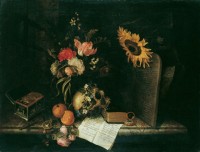
Maria van Osterwijk. Still life

D. Annenkov "Rozdumi with Baudelaire"
Vanity can include dances of wine, musical instruments or books: speeches, as we should be on earth, or we cannot take life with us beyond the grave. Isn't it all just old Dutch maestri? At the eighteenth century, as a rule, vvazhamosya all hour Maystr still life. Instead of vikoristovuvati traditional symbolism, Shardin simply pragnuv present a warehouse of objects known in his vlasny booth.
The parts of the chardi are tse, mabut, engaging with still life: simple objects that do not conceal symbolic meaning, are simply attached to achieve their rivnovagi and odnosti, which are presented beautifully. Let's enjoy my maєmo, my still life looks like a place with the styles of the old majesty and the bigger cubists. Still life of Cézanne is seen by the time, which includes a circle of different points of view: mayzhe is like a stem of sculpture. The stench to bring in the light and wonderful composition with fruits, in some cases, may not be smooth in the picture.
Still life in Russian painting
In Russia, still life as an independent genre appeared on the ear of the 18th century. Ale deyakiy hour (mayzhe do end of XIX c.) still life in the lower genre and depicting only kits and fruits.
We will see an artist of this genre in the 19th century. bouv І. Khrutsky.

In a whole hour, absolutely, I’m not guilty of forgetting, whose still life is on the floor, and the stench of the stench can be found in the very vivid shanuvalniks of the painting. How can life crumble forward? As soon as we know it, we will move forward, we will go over to the cubism of the XX century. and once they were victoriously forming and blocking the forms, the still lifes were watched radically from their alternatives. When photographs appeared, the artists sounded in order to tie up small objects, but they would be more true for life: the stench could experiment with the mood, color, shape and feel, and not with the pure technique of capturing the correct blaze for the orange.
І. Khrutsky. Still life with a vase (one thousand weighing thirty two)
![]()
І. Khrutsky "Quite and Fruit" (1838)
At the twentieth century. Russian still life painting has become equal to the middle genres. The artists worked over the fineness of color, form, composition, the genre became quickly developed.
See Russian and Radiansk artists who worked and painted in the genre of still life: Kostyantin Korovin (1861-1939), Igor Grabar (1871-1960), Petro Konchalovsky (1876-1956), Kuzma Petrov-Vodkіn (1880-1972), Ilya Mashkov (1881-1944), Olena Skuin (1909-1986), Petro Alberti (1913-1994), Sergiy Osipov (1915-1985), Evgenia Antipova (1917-2009), Viktor Teterin (1922 - 1991), Maya Kopitseva (1924-2005), Yaroslav Krestovsky (1925-2003), Volodymyr Stozharov (1926-1973), Boris Shamanov (1931-2008) іn.
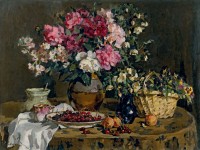
E. Skuin "Pivonia and Cherry" (1956)
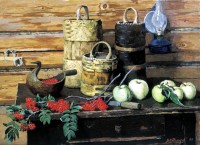
V. Stozharov. Still Life with a Gorobino (1969)
Still life in different styles and within the art
Rubіzh XIX-XX cent. with experiments in the area artistic creativity... Still life is also not unconscious of the tsієї dolі. The first to experiment with still life were Paul Cezanne, Paul Gauguin, Anri Matiss and іn.
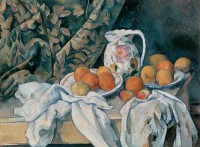
P. Cezanne. Still life with draperies (1889). Ermіtazh (St. Petersburg)
Smily experimenting cubist P. Picasso.

P. Picasso "Glechik, cell and book" (1908)
J. Schlyub also worked in the style of cubism.
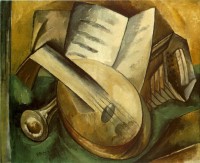
J. Schlub "Musical Instruments" (1908)
Cubo-futurism was playing in the jokes of the new spacious-hour vimir.
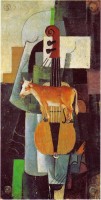
K. Malevich "Cow and Violin" (1913). State Russian Museum (St. Petersburg)
Yogo "... intuitively perceived in his speeches the energies of dissonance, the removal of the two prototypical forms" (K. Malevich "From Cubism and Futurism to Suprematism").
In the metaphysical still lifes of Giorgio Morandi (1890-1964), objects move one to one, setting up a group, the Germans take great care of the warmth, being afraid of the outrageous cold and aggression.

Giorgio Morandi. Natura Morta (1956)
The most familiar representative of surrealism, Salvador Dali, in his famous work "The Steel of Memory", which is an allegorical still life in essence, is developed about the vitality of the hour.

S. Dali "The persistence of memory" (1931)
Commercial advertising of the other half of the XX century. she wiggled in people greedy vіdnoshennya to speeches і nourish happiness. In the obviousness of the fetishization of the subject. The elements of the still life genre can be repaired from the painting to the dzherelo life.

Endi Warhol, Campbell's Soup Can (1968)
Dmytro Krasnopevtsev represents Russian "neofitsiyne" mystery, I would like to get a complete official classic artist education (having finished the Moscow Art Institute for Men of V. I. Surikov).
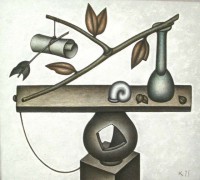
D. Krasnopevtsev. Still life
The main genre of Krasnopevtsev is a "metaphysical still life" close to surrealism with simple, often beaten ceramics, dry dews and shells. Tsi robots, written in peasant tones, develop the motive of the lucidity and unreality of the light.
And the axis of the still-life painting bitchy artist Dmitra Annenkov with the whole "spiritualization". The stench of rіznі: radіsnі, sumnі, smіshnі, alto whole life. Oh, I want to touch it. Marvel at the still life, uncomfortably settling down in the face of a kind smile.
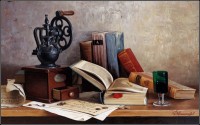
D. Annenkov "Still life with cavomolka"
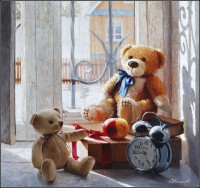
D. Annenkov "Vesnyane Sonce"

D. Annenkov "Help about lito"
